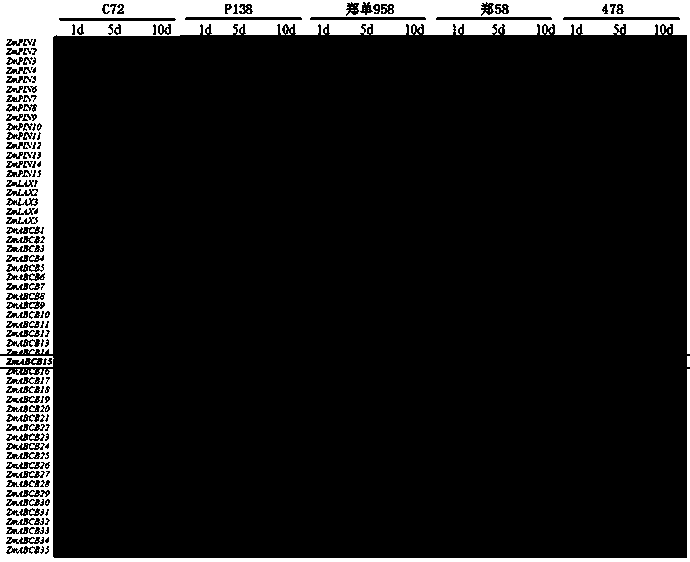Maize auxin transport gene ZmABCB15 as well as application thereof in resisting rough dwarf virus
A technology for transferring genes and auxin, which is applied in application, genetic engineering, plant genetic improvement, etc., can solve the problem that corn germplasm resources cannot meet the needs of corn production, achieve reliable materials and data support, reduce proliferation rate, and improve resistance. sexual effect
- Summary
- Abstract
- Description
- Claims
- Application Information
AI Technical Summary
Problems solved by technology
Method used
Image
Examples
Embodiment 1
[0034] Example 1: Maize auxin transport carrier encoding gene ZmABCB15
[0035] 1. Select 5 maize materials with different resistance to rough dwarf disease commonly used in current production, which are two rough dwarf resistant materials (Chang 72, P138), hybrids of Zheng 58 and Chang 7-2 ( Zheng Dan 958) and two rough dwarf disease-susceptible materials (478, Zheng 58) used corn rough dwarf virus SRBSDV to infect the above materials.
[0036] The specific method of virus inoculation test is as follows:
[0037] (1) Feeding experiment of SBPH
[0038] In spring, SBPH was captured from wheat seedlings and weeds in the field, and after removing the source of heterogeneous insects, it was brought back to the laboratory for artificial breeding and subculture. Large-scale artificial rearing of SBPH is carried out in a special insect culture room, using the beaker rearing method. Keep a constant temperature of 25°C in the insect rearing room, and adjust the indoor humidity to ...
Embodiment 2
[0047] Example 2: Maize auxin transport carrier gene after different resistant maize materials were infected by crude contraction virus ZmABCB15 Expression changes and virus particle content analysis
[0048] The virus content and virus proliferation rate of 5 different resistant corn materials were measured before and after corn infection with rough dwarf disease virus RBSDV (same as Example 1).
[0049] The concrete step method of virus proliferation detection experiment in corn plant is:
[0050] Total RNA from maize leaves was extracted using ZYMO RESEARCH (USA) Direct-zol™ RNA MiniPrep kit, and reverse transcribed into cDNA. According to the nucleotide sequence of the RBSDV S6 fragment, RT-PCR specific primers specially used for amplifying RBSDV were designed, namely:
[0051] F: 5'--TCA GCA AAA GGT AAA GGA ACG--3';
[0052] R: 5'--GCT CCT ACT GAG TTG CCT GTC--3'.
[0053] Applying the fluorescent quantitative PCR absolute quantitative method to detect unknown samples...
Embodiment 3
[0063] Example 3: ZmABCB15 protein subcellular localization
[0064] ZmABCB15 The cDNA clone of the gene was then constructed into the intermediate pMDT-20 vector. After sequencing, the 35S-GFP vector pH7FWG2.0 was constructed to obtain the recombinant vector 35S-ZmABCB15:GFP, and transformed into tobacco leaf protoplasts. Membrane protein marker protein 1008 (provided by the State Key Laboratory of Plant Physiology and Biochemistry, Zhejiang University) was used for co-infection, and the localization was observed with a LSM710 confocal microscope.
[0065] Such as Figure 7 As shown, the ZmABCB15 protein functions as an auxin transport carrier cell membrane localized.
PUM
 Login to View More
Login to View More Abstract
Description
Claims
Application Information
 Login to View More
Login to View More - R&D
- Intellectual Property
- Life Sciences
- Materials
- Tech Scout
- Unparalleled Data Quality
- Higher Quality Content
- 60% Fewer Hallucinations
Browse by: Latest US Patents, China's latest patents, Technical Efficacy Thesaurus, Application Domain, Technology Topic, Popular Technical Reports.
© 2025 PatSnap. All rights reserved.Legal|Privacy policy|Modern Slavery Act Transparency Statement|Sitemap|About US| Contact US: help@patsnap.com



